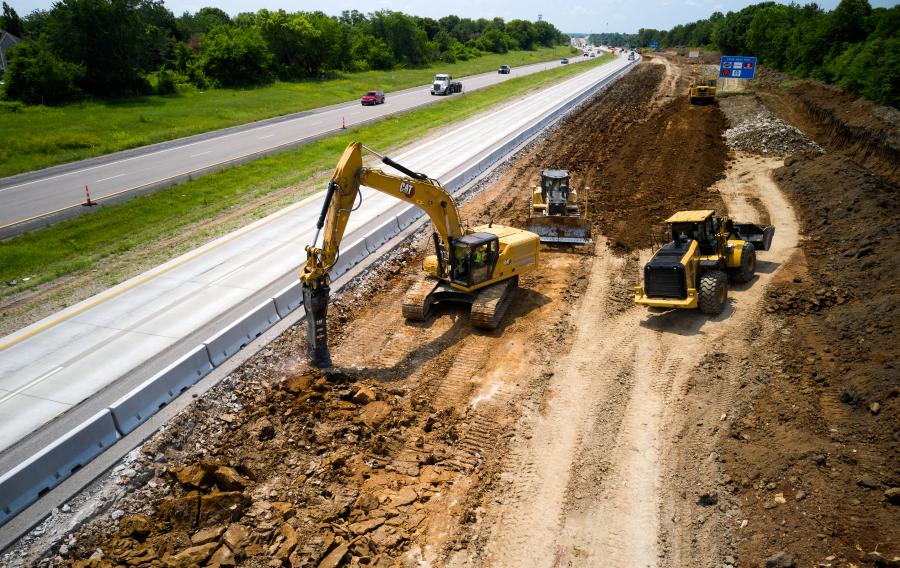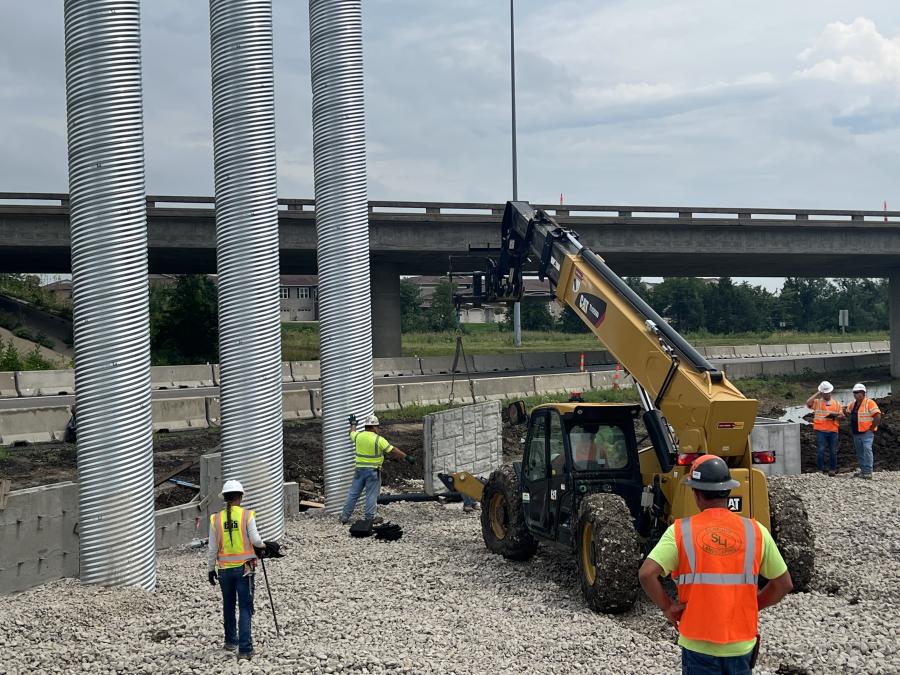The Kansas Department of Transportation is overseeing a $570 million project that will build express toll lanes on U.S. 69 Highway in Overland Park.
(U.S.-69 Express Constructors photo)
With a continued focus on community input, the Kansas Department of Transportation (KDOT) is overseeing a $570 million project that will build express toll lanes on U.S. 69 Highway in Overland Park. The mission of 69Express is to help commuters travel to their destinations quickly and safely.
"U.S. 69 is the busiest four-lane highway in Kansas," said Steve Rockers, KDOT project director of 69Express. "The city of Overland Park and the surrounding area continue to grow, creating increasing safety, travel-time reliability and congestion issues on the roadway."
The 69Express corridor, which stretches from 103rd Street to 179th Street in Overland Park, has crash rates that are 53 percent above the statewide average. Existing pavement and bridges are approximately 50 years old and are overdue for replacement. Peak travel times are expected to triple by 2030.
"The goal of the U.S. 69 express lanes is to address traffic congestion with a solution that is sustainable far into the future, as traffic continues to grow in the corridor," said Rockers. "Express lanes do a better job of reducing congestion and improving travel-time reliability, because they can be managed to ensure a congestion-free trip. Drivers choose if they want to pay a toll to drive in the free-flowing express lanes, which in turn helps reduce congestion in the toll-free, general-purpose lanes."
In addition to the express lane improvements alleviating traffic congestion and providing reliable travel times, the project will improve roadway pavement, bridges and five key interchanges in the corridor.
Rockers noted that input from the public plays an important role in the 69Express project.
"In addition to years of outreach connected to previous studies regarding how to improve U.S.69, in the 15 months prior to the project proposal, the project team has, among other efforts, interviewed community leaders; convened focus groups with corridor users; undertaken several statistically valid surveys; and conducted multiple online and in-person community briefings and public meetings, all to gather feedback on the best approach for U.S. 69.
"Now that construction is under way, the project team regularly communicates with the public via the project's Facebook and Twitter pages and the project website, 69Express.org."
As for how drivers are responding to necessary closures, said Rockers, "Our design-build team has developed an innovative strategy to maintain traffic through the corridor during construction. Much of the work is being done at night to mitigate traffic impacts. This approach has kept the need for closures to a minimum and allowed us to keep traffic flowing well during construction, particularly during peak-hour travel times.
"In the few instances where a closure has been necessary, the traveling public has responded well and utilized detour routes. A robust communications campaign alerts drivers to all construction closures and updates."
As with all major infrastructure projects, the work is being completed as a team effort.
"The Kansas Department of Transportation is working in conjunction with the Federal Highway Administration, the Kansas Turnpike Authority and the city of Overland Park," said Rockers.
"Our design-build team joined that partnership in 2022 to help us design and construct these critical infrastructure improvements. The U.S. 69 Express Constructors design-build team is a joint venture of Ames Construction and Emery Sapp and Sons, and the design firms of Parsons and GBA."
Construction is supported through federal and KDOT funds, with tolls from the express lanes funding a contribution from the City of Overland Park.
Construction began in March 2023. According to Rob Gullikson, project manager, U.S. 69 Express Constructors, the first few months required temporary pavement widenings to accommodate future phases of the project, with significant consideration to Maintenance of Traffic (MOT) phasing.
"Almost all elements of permanent construction are now under way. Bridge construction is in progress at 143rd, 139th, 135th, Tomahawk Creek, Blue Valley Parkway, Indian Creek, College Avenue, North-Branch Creek and I-435. Many of the bridges include mechanically stabilized earth [MSE] walls. Between the bridges, both roadway grading, detention basin excavation and fill area grading is taking place."
Storm drainage work is occurring in these areas, with both reinforced concrete pipe (RCP) and concrete box culverts (CBC) being placed. The CBCs utilize both pre-cast sections and cast-in-place work, depending on foundation and embankment situations.
"Many of the bridges and/or drainage pipes utilize soil-nail walls, or similar, to support excavation," said Gullikson. "In addition to general grading for the mainline, sections call for 12-inch subgrade stabilization; 4-inch cement-treated base [CTB]; and 12-inch PCCP pavement, all which are ongoing. The project involves extensive MOT with approximately 50,000 linear feet of temporary barrier currently onsite protecting work areas from travel lanes."
The project also requires construction of almost a dozen noise walls. Approximate wall locations and heights were determined by specific studies. The locations were refined based on the design-build approach with roadway, utility and other alignments.
Supplemental geotechnical borings determined shaft size and other detail elements. The contractor will self-perform construction of some walls and will rely on a subcontractor to supplement and maintain construction progress, which includes close coordination with fabricators for delivery schedules.
Gullikson explained that developing plans for the design-build project was critical for the start of construction.
"We formed a very early partnership between the contractor, designers and KDOT to determine appropriate release packages either by scope, areas, stages of project wide. This led to approximately 80 release packages with varying due dates, considering the construction schedule, as well as permitting, procurement, review timelines, etc."
Gullikson said in addition to dealing with a fast-paced schedule and working near live traffic, crews have struggled with utilities in the field.
"Aside from the sheer number and proximity of utilities, identifying the locations themselves has been challenging, and has led to additional potholing in some cases to ensure safety and avoid potential strikes.
"Other challenges come from unforeseen site conditions. Rock was anticipated within several excavation areas, but has varied from preliminary expectations and, in some cases, has added to the schedule duration."
The JV is self-performing all grading, storm sewer, bridges, temporary and permanent paving. The project has two concrete batch plants on-site, along with a CTB pugmill, pavers, excavators, dozers, loaders, a Caterpillar 623 scraper, Caterpillar 740 off-road haul trucks, rollers, cranes, forklifts, a manlift, light plants and generators.
The U.S. 69 express lanes are scheduled to be completed by the end of 2025. The entire project, including the West 167th Street interchange, should be finished by 2026. Gullikson credited the field staff, JV partners, KDOT, inspection staff, subcontractors and suppliers with laying the foundation for a successful project.
"The strong relationships and partnership approach among these parties has led to a great start and provides confidence that we'll be able to share future success stories." CEG
Cindy Riley
Birmingham, Ala., native Cindy RIley originally planned on a career in law, but during her sophomore year in college realized journalism was her true calling. A magna cum laude graduate of Samford University, Riley first worked in radio and TV. Named Best News Anchor, Best News Reporter and Best Investigative Reporter by the Associated Press, she interviewed numerous personalities, ranging from Dr. Henry Kissinger and President Bush to Michael Jordan and Captain Kangaroo.
As a print journalist, Riley has covered a variety of topics, including construction, business, health and the arts. In addition to CEG, her work has appeared in special reports for USA Today and the L.A. Times. Other publications have included New South Magazine, Portico, Thicket, Alabama Heritage, B-Metro, Business First and Birmingham Business Journal.
Read more from Cindy Riley here.
Today's top stories





















